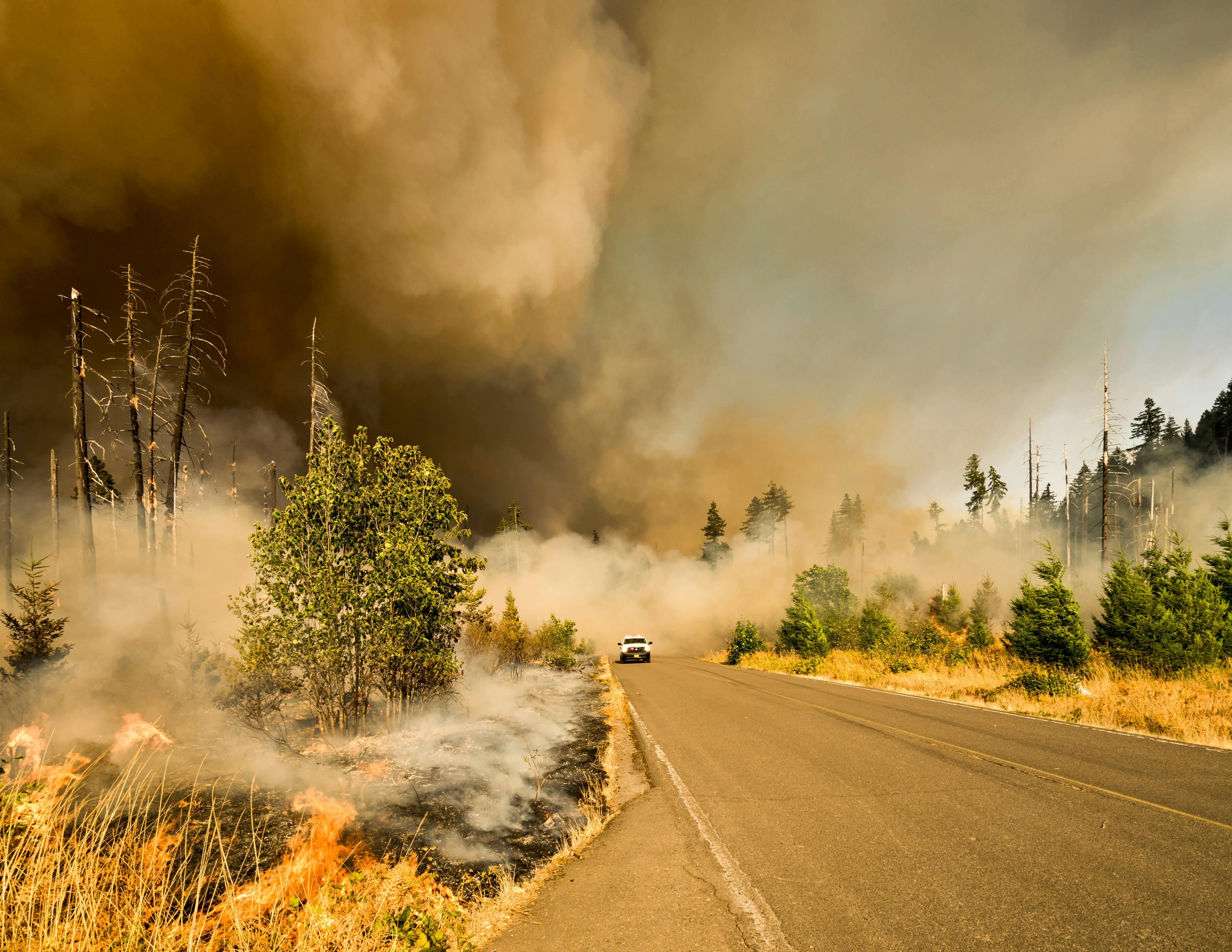- Home
- Dog Wellness
- How Bad is Wildfire Smoke for My Pet?
3 min read
How Bad is Wildfire Smoke for My Pet?

By Mel Lee-Smith
Published: 09/01/2021, edited: 06/17/2022
Save on pet insurance for your pet
You don't have to choose between your pet and your wallet when it comes to expensive vet visits. Prepare ahead of time for unexpected vet bills by finding the pawfect pet insurance.
Wildfires are becoming deadlier and spreading farther every year, so knowing how to keep your pets safe in a wildfire is imperative if you live in a high-risk area. We know how dangerous wildfire smoke can be for humans, but what about our pets? According to Dr. Jamie Craven, a veterinarian based in Chattanooga, pets experience the same effects as humans when inhaling wildfire smoke.
Keep reading to learn what wildfire smoke consists of, which pets are especially vulnerable to it, and how you can keep your fur-babies safe during wildfire season.
How bad is wildfire smoke for my pets?
Every wildfire is different. The contents of the smoke vary depending on an array of factors, like the temperature of the fire and the materials burned.
Roughly 80% of wildfire smoke is comprised of fine particulate matter. (A human hair is more than 30 times larger than the biggest fine particles.) Fine particles are especially dangerous because they can infiltrate the lungs, pass into the bloodstream, and settle deep within the body. In humans, this triggers an immune response, which releases the same cells that fend off viruses.
Unfortunately, that immune response doesn't break down those particles, which increases the risk of chronic inflammation. To make matters worse, prolonged exposure to wildfire smoke keeps the ineffective immune response active for longer, which can damage the major organs.
Inflamed sinuses and nasal passages can produce excess mucus. Dogs often swallow this mucus, which can lead to vomiting. Other symptoms of wildfire smoke exposure include:
- wheezing
- shallow breathing
- excessive sneezing
- watery eyes
- coughing
- drooling
- panting
- excessive vocalization
- inflammation of the face, mouth, and throat
- loss of coordination
- irregular heartbeat
Pets that are especially vulnerable to wildfire smoke
- Puppies and kittens
- Senior dogs and cats
- Brachycephalic dog breeds (including Pugs, Bulldogs, and Boxers)
- Short-nosed cat breeds (including Burmese cats, Persians, and Himalayans)
- Dogs and cats diagnosed with respiratory conditions (including pneumonia, chronic bronchitis, and pulmonary fibrosis)
What's in wildfire smoke?
Carbon monoxide, nitrogen dioxide, and polycyclic aromatic compounds are just a few toxins that comprise wildfire smoke. A study by the California Air Resources Board found that wildfires can also increase lead, zinc, and iron levels in the air by up to 50 times. Below, we've detailed how these toxins affect your pets' health.
Carbon monoxide
Hemoglobin is a molecule in the blood that transports oxygen from the lungs to the tissues. Conversely, hemoglobin prefers to bind with carbon monoxide over oxygen. So when your pet breathes in wildfire smoke that contains high levels of carbon monoxide, hemoglobin picks it up instead of the oxygen and carries it throughout the body. This is one reason why carbon monoxide poisoning is so dangerous.
Nitrogen dioxide
Nitrogen dioxide (and other nitrogen oxides) produce nitrate particles, which contribute to the hazy appearance of wildfire smoke. Nitrogen dioxide can suppress your pet's immune response, making them more susceptible to bacterial infections by reducing the amount of specialized white blood cells circulating throughout the body.
Polycyclic aromatic compounds
"Polycyclic aromatic compound" (PAC) is an umbrella term for a variety of environmental contaminants. PACs occur naturally in coal and fossil fuels. When burned, they can linger in the air for a long time and are difficult to break down. While less is known about PACs' effects on the body than other toxins, research shows some PACs can cause cancer and damage the reproductive organs and immune system.
How to protect your pet from wildfire smoke
Below, we've covered 3 tips for protecting your pet from wildfire smoke inhalation. For more detailed guidance, check out our article on keeping your dog safe from wildfire smoke and poor air quality.
Invest in an N-95 mask for your dog
The surgical masks used to minimize the spread of COVID-19 won't protect you or your pet from wildfire smoke. N-95 masks are available for dogs — and if you'll be spending a significant amount of time outdoors in an area with heavy smoke, you might want to buy one.
Be sure to choose a mask that's approved by the National Institute for Occupational Safety and Health (NIOSH). However, respirator masks make it hard to breathe, so use them sparingly and only when necessary.
Bring your cats inside
If you let your cats roam, bring them indoors to keep them safe. This will not only protect them from inhaling wildfire smoke, but it will also keep them safe from other wildfire hazards, like severe burns.
Stay updated on weather conditions
Check the air quality index in your area regularly. Download the National Weather Service app to get alerts on wildfires in your area. You'll receive Wireless Emergency Alert (WEA) messages on your phone if you're required to evacuate.
If you live in an area that's prone to wildfires, consider investing in pet insurance. Insuring your pet protects you from high vet costs related to severe symptoms of smoke inhalation. Use our pet insurance comparison tool to see how pet insurance providers and policies stack up!
You may also like
